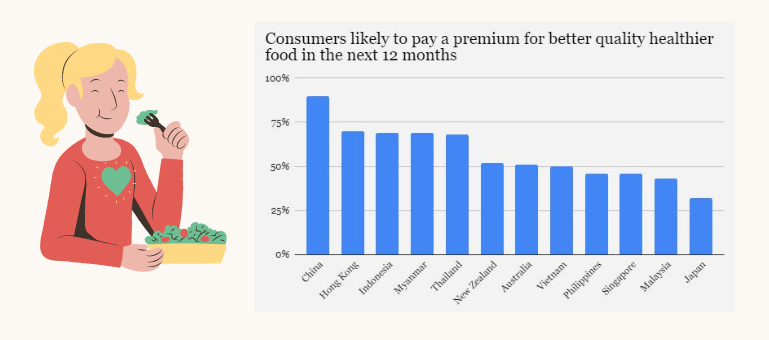Asia, known for its diverse culinary traditions and rich heritage, continues to captivate global attention with its innovative and ever-evolving food scene.
In this blog, we’ll look at the emerging trends in the food and beverage industry that redefine how we enjoy food and drinks in this dynamic region.
The Food and Beverage industry in Asia is a fusion of various cultures, each year bringing exciting culinary advancements that influence consumer preferences and market directions.
With a comprehensive option of unique flavors and ingredients, this diverse landscape presents impressive opportunities for consumers and businesses.
This blog will discuss insights into the F&B market and new culinary concepts that characterize the current Asian food scene.
From sustainable practices and health-focused menus to the integration of advanced food technology, these trends are reshaping how people dine and engage with food.
Let’s delve into the top five trends in Asia’s food and beverage industry for 2024, providing an overview of the transformative influences shaping the F&B landscape in the year ahead.
1. Plant-based Revolution
The plant-based revolution is making waves in Asia’s food and beverage scene, ready to reshape our eating habits and perceptions of food.
As we enter 2024, this impactful trend is picking up speed, fueled by an increasing focus on sustainability and the demand for healthier food choices. According to Kline’s forecast on the growth of the global plant-based meat industry, this market is projected to reach a value of USD 8.35 billion by 2024.
Below are a few key numbers highlighting the progress of the plant-based revolution in Asia:

The plant-based revolution’s core is a shift from traditional animal-based foods to a diet focused on plant ingredients.
This culinary movement spotlights fruits, vegetables, whole grains, and plant-based proteins, creating various flavors and textures. It’s also transforming Asia’s market for alternative proteins.
The impact of this revolution goes beyond just vegetarian and vegan options. Restaurants, cafes, and even fast-food chains now add plant-based and alternative protein dishes to cater to changing consumer preferences.
Food innovators and chefs are pushing the limits of plant-based cooking, creating delicious dishes that can compete with those made from animal products.
In addition, this revolution supports the global move towards sustainability and reducing our environmental impact.

Asia’s food and beverage industry is making significant progress towards a more eco-friendly and ethical future by decreasing its reliance on animal farming.
In 2024, the plant-based revolution is on track to change how people eat in Asia, turning plant-based dishes into a trend and a central part of the region’s food culture.
Rise of Plant-Based Diets in Asia
Plant-based diets are becoming incredibly popular in Asia, and their impact on the region’s food and beverage industry for 2024 is truly transformative.
Plant-based diets reshape the culinary scene as more people prioritize health and sustainability.
Choosing plant-based diets, which focus on fruits, vegetables, grains, legumes, nuts, and seeds, has become a trend for a few key reasons.
Firstly, it aligns with the growing awareness of environmental concerns, as plant-based diets generally have a smaller carbon footprint than meat-heavy diets.
Asia’s population has become more environmentally conscious, so they’re turning to sustainable food choices to contribute to a greener world.
Secondly, health is a significant factor driving the popularity of plant-based diets. With a growing emphasis on well-being and nutrition, many Asian consumers are realizing the health advantages of plant-based eating. This reflects people’s willingness to invest in healthier food options.

The rise of plant-based diets has led to a surge in plant-based cuisine across the region. Restaurants and eateries embrace this trend by introducing innovative and delicious vegan dishes.
The market for vegan food is flourishing, with various plant-based alternatives for meat and dairy products becoming widely accessible. According to the Future Marketing Insight report, there’s a steady estimated growth of 6% CAGR in the demand for vegan Asian food.
The sustainable food movement has become integral to Asia’s food and beverage industry, and businesses are meeting the increasing demand for plant-based choices.
From plant-based fast-food outlets to upscale vegan restaurants, the food scene is undergoing an exciting transformation due to the rising popularity of plant-based diets.
As this trend gains momentum, Asia’s food and beverage industry in 2024 will experience a significant shift towards more sustainable, environmentally friendly, and health-conscious options.
Adopting plant-based diets in Asia offers a delightful culinary experience and contributes to a more sustainable and compassionate world.
2. Technology Integration
The fusion of technology is improving the evolution of Asia’s food and beverage industry, reshaping how we engage with and enjoy food.
As we enter 2024, the smooth integration of technology is transforming every facet of the culinary world, spanning food preparation, delivery, and customer interactions.

One of the notable advancements in technology integration in the food and beverage industry is the emergence of AI-driven solutions and robots to address labor shortages.
Artificial Intelligence (AI) is utilized to optimize various operations, including managing inventory, coordinating supply chains, and developing recipes.
Modern kitchens equipped with state-of-the-art technology streamline food preparation and enhance overall efficiency.
This technological revolution is also evident in food delivery services. Food delivery apps and platforms have become essential in Asian dining, offering unmatched convenience and variety to customers.
Incorporating GPS tracking, real-time updates, and efficient delivery logistics has turned food delivery into a smooth and dependable experience.
From AI-driven improvements in kitchen processes to the effortless ease of food delivery apps, technology is boosting effectiveness, eco-friendliness, and overall customer contentment.
As establishments adopt these innovations, the forthcoming culinary scene in Asia is poised to blend tradition and modernity, crafting memorable dining moments for culinary fans throughout the region.
Advancements in Food Technology
The influence of technology on Asia’s food and beverage industry is reshaping how we enjoy our favorite dishes and how F&B stakeholders present the dishes.
The growing integration of food technology, AI-driven kitchen enhancements, and efficient delivery services are reshaping the culinary scene.
An area where technology is leaving a profound mark is food delivery services. Across Asia, food delivery apps have become popular, providing an easy and convenient way to savor diverse cuisines from the comfort of our homes.
These platforms have transformed the food ordering experience, offering a variety of choices and ensuring prompt deliveries, presenting a modern and inventive approach to online food delivery.

Source: Statista
Moreover, the emergence of AI-powered kitchen innovations is transforming the operations of restaurants and food businesses.
Intelligent kitchens equipped with AI-driven tools optimize cooking processes, streamline operations, and elevate the quality of dishes. This infusion of technology enhances efficiency and grants chefs more time for creativity and experimentation.
Along with enriching the customer experience, technology offers a data-centric approach for businesses to cater to consumer preferences.
By analyzing food trends and customer behavior, restaurants can tailor their offerings, improving customer satisfaction and increasing brand loyalty.
As we witness progress in food technology, AI, and delivery services, how we access and enjoy food in 2024 will be shaped by the smooth fusion of innovation into our dining experience.
3. Fusion Flavors
Fusion flavors are taking center stage in Asia’s food and beverage industry, delighting the taste buds of food lovers and reshaping different cuisines.
In 2024, the trend of fusion cuisine is growing stronger as chefs boldly explore a blend of different cultural inspirations.
This culinary movement goes beyond sticking to one cooking style, skillfully mixing ingredients, cooking methods, and spices from different cultures.
The result is a beautiful blend of flavors that surprise and delight diners, providing a one-of-a-kind and unforgettable dining experience.
Asian fusion restaurants are leading this trend, presenting creative dishes that flawlessly combine elements from various Asian cuisines.
Fusion flavors know no limits, from Korean-style tacos to pizzas with Indian-inspired twists and pasta infused with Japanese flavors – you can taste the culture of multiple regions through one dish.

Chefs are now creating art with food, taking inspiration from global culinary traditions and their cultural roots. The result is a blend of flavors that showcase the diversity of Asian cuisine.
In 2024, fusion flavors in Asia are taking diners on a remarkable culinary experience that can cross borders and create delicious delicacies.
As the fusion trend continues to evolve, it brings a joyful celebration of culinary diversity and a merging of cultures that brings joy to food enthusiasts and strongly impacts the region’s culinary scene.
Culinary Creativity with Fusion Cuisine
The fusion cuisine trend is taking over Asia’s food and beverage industry, bringing together diverse cultural influences on a single plate.
Chefs throughout the region are pushing culinary boundaries, combining flavors, techniques, and ingredients from different traditions to create unique and exciting dishes that delight the palate.
Fusion cuisine breaks culinary barriers and embraces diversity, blending elements from various cultures and cuisines.
This culinary movement allows chefs to experiment with new flavor combinations, creating an epic combination of familiar and fresh tastes.
The rise of Asian fusion restaurants showcases the growing popularity of this culinary trend.

These establishments creatively marry ingredients and cooking methods from various Asian countries, offering a fascinating culinary experience for diners.
Creative food blending has become an art form for visionary chefs who draw inspiration from their cultural heritage and global influences.
Whether it’s a fusion of Japanese and Mexican flavors, Thai and Italian, or Indian and French, these cross-cultural fusions present a delightful adventure for adventurous foodies.

Fusion cuisine in Asia’s food and beverage industry celebrates diverse flavors and reflects the region’s multiculturalism.
As chefs explore new horizons, fusion cuisine transforms culinary experiences, offering a fresh take on modern Asian gastronomy.
4. Health and Wellness Focus
Health and wellness are vital trends shaping Asia’s food and beverage industry this year. As people prioritize their overall well-being, they’re looking for food choices that are good for their bodies and minds.

Source: The Asia Food Challenge
As more people in Asia focus on their health, there’s a growing interest in menus that promote wellness. Functional foods providing extra health benefits and nutrition are becoming more popular.
Ingredients like superfoods, probiotics, and adaptogens are used in dishes and drinks, making meals even healthier.
The focus on health and wellness is leading to a change in eating habits. People in Asia are adopting mindful eating, enjoying each mouthful, and paying more attention to how much they eat and what’s on their plate.
As this trend keeps growing, we’ll likely see more importance placed on nutrition, well-being, and the desire for a healthier way of life throughout the region’s food scene.
The Rise of Wellness-Oriented Menus
The desire for healthier eating is rising in Asia’s food and beverage industry as people focus more on their well-being. In 2024, the trend is moving towards foods that are good for the body and offer functional benefits, promoting a holistic dining experience.
Health and wellness are now crucial for consumers and businesses in the food and beverage industry.
This trend is particularly evident in Asia, where people seek food choices that align with their goals for well-being, such as maintaining a balanced diet, boosting immunity, and feeling more energetic.
Functional foods play a significant role in this movement by offering extra health benefits beyond essential nutrition.
Ingredients like superfoods packed with antioxidants and essential nutrients are being incorporated into menus to contribute to the wellness trend.
Restaurants and eateries are responding to this growing demand by creating menus that cater to different dietary preferences, like plant-based, gluten-free, and low-calorie options.
The focus is serving tasty and nourishing meals that enhance the dining experience while promoting customers’ well-being.
As the wellness movement gains momentum in 2024, Asia’s food and beverage industry embraces this shift towards a health-conscious and nutrition-focused approach.
The food and beverage business significantly promotes wellness and healthier lifestyles in the region.
By focusing on their customers’ well-being and introducing nourishing trends, these businesses contribute to a healthy culture and encourage people to adopt healthier habits.
5. Sustainability and Ethical Sourcing
In 2024, the focus on sustainability and ethical sourcing is becoming more prominent in Asia’s food and beverage industry. Both consumers and businesses are placing a greater emphasis on responsible practices and caring for the environment.
As people become more aware of how food production affects the planet, they seek sustainable options that do minimal environmental harm.
From initiatives connecting farm to table to efforts in reducing food waste and using sustainable food packaging, environmental impact is crucial for restaurants and food establishments.

Ethical sourcing is gaining importance in the industry. Consumers want to know where ingredients come from and if they are sourced responsibly, with fair labor practices and animal welfare in mind.
Asia’s food and beverage industry is responding by working with local farmers, supporting community projects, and using eco-friendly practices.
Restaurants highlight seasonal and local ingredients, reducing their environmental impact while offering fresh, delicious meals.
As this trend continues in 2024, businesses focusing on sustainability and ethical sourcing will appeal to conscious consumers who value ethical choices.
By adopting these practices, Asia’s F&B industry leads toward a greener and socially responsible culinary experience.
Embracing Sustainable Practices
In 2024, Asia’s food and beverage industry is experiencing a clear move towards sustainable practices. Both consumers and businesses focus on being environmentally conscious and using responsible sourcing.
The growing use of sustainable and ethically sourced ingredients is changing how food is prepared and served. This change is motivated by a shared dedication to protecting the planet and upholding ethical values.

Source: The Asia Food Challenge
Sustainability is a critical focus in this movement, guiding businesses to decrease their environmental impact.
From using local and organic ingredients to reducing food waste and adopting eco-friendly packaging, restaurants actively promote sustainable food production.
Ethical sourcing is also essential, especially for eco-conscious consumers. As the demand for transparent supply chains increases, responsible practices, fair trade, and animal welfare are central ingredient sourcing considerations.
In 2024, sustainable practices in Asia’s F&B industry will not just be a passing trend but a core principle shaping its evolution.
By embracing ethical and environmentally friendly sourcing, businesses show their dedication to the well-being of the planet and future generations.
As consumers continue to support sustainable businesses, adopting these practices in the F&B industry contributes to a more eco-friendly and responsible future for Asia’s culinary scene.
6. Functional Health Beverages

Market analyses underscore a robust upward trajectory for functional health beverages in Asia. According to recent reports from market research firm Statista, the functional beverage market in Asia is poised to experience a remarkable CAGR of 10.5% over the next five years. This substantiates a notable shift in consumer preferences towards beverages that offer additional health benefits.
The trend towards functional health beverages has spurred a wave of innovative products from industry leaders. For example, renowned wellness beverage brand NutriVibe has introduced a line of plant-based, immunity-boosting drinks enriched with superfoods like turmeric and ginger. This product resonates with consumers who prioritize beverages as an integral part of their wellness regimen.
Functional health beverages increasingly incorporate adaptogens and natural extracts celebrated for their health-enhancing properties. Brands such as Herbal Harmony capitalize on the adaptogenic trend, offering beverages infused with stress-relieving herbs like ashwagandha. This aligns with consumer preferences for holistic wellness solutions.
The surge in functional health beverages can be attributed to a growing health-conscious consumer base. A survey conducted by HealthWatch Asia revealed that 75% of respondents consider health benefits a crucial factor in beverage choices. This reflects a significant consumer-driven demand for products that refresh and contribute positively to their overall health.
Industry leaders, including PepsiCo’s Tropicana Essentials and Coca-Cola’s SmartWater+, have embraced the functional health beverage trend. Tropicana Essentials incorporates vitamin-rich juices with added nutrients, while SmartWater+ offers enhanced hydration with electrolytes. These prominent brands are committed to meeting evolving consumer demands for health-centric beverages.
7. Self-Service Kiosks

Self-service kiosks represent a significant departure from traditional ordering systems, empowering customers to take control of their dining experience. As reported by TechAsia, the Asia-Pacific region has witnessed a substantial surge in the deployment of self-service kiosks, with a projected market growth of 12% over the next year. This indicates a substantial shift towards tech-driven dining dynamics.
The rise of self-service kiosks aligns with consumers’ increasing preference for convenience and efficiency. Diners appreciate the autonomy to browse menus, customize orders, and complete transactions at their own pace. Notably, fast-food chains like McDonald’s and KFC have successfully implemented self-service kiosks, streamlining ordering processes and reducing wait times.
The ongoing global health situation has expedited the adoption of contactless solutions, and self-service kiosks perfectly align with this trend. Industry reports highlight that 68% of Asian consumers prioritize contactless dining experiences. Self-service kiosks offer a touch-free alternative, addressing safety concerns and providing a sense of reassurance to diners.
Self-service kiosks cater to the need for convenience and present opportunities for businesses to enhance customer engagement. By integrating intelligent upselling prompts and customization features, establishments can effortlessly encourage patrons to explore additional menu offerings, contributing to increased average transaction values.
Primary food and beverage sector players like Starbucks and Pizza Hut have embraced the self-service revolution. Starbucks’ implementation of mobile order and pay kiosks enhances the customer journey, while Pizza Hut’s interactive kiosks allow diners to customize pizzas effortlessly. These industry leaders showcase the adaptability and benefits of self-service kiosks in diverse culinary settings.
8. Cultivated Meat

Cultivated meat, called lab-grown or cell-based, offers a sustainable alternative to conventional animal agriculture. According to a report by the Good Food Institute, Asia-Pacific countries are showing increased interest in alternative protein sources, with a notable surge in investments in cultivated meat startups. This reflects a growing awareness of the environmental impact of traditional livestock farming.
Traditional meat production is resource-intensive, contributing significantly to deforestation, greenhouse gas emissions, and water pollution. Cultivated meat, produced through cellular agriculture, can potentially reduce the environmental footprint associated with livestock farming. Providing a more sustainable protein source aligns with the region’s commitment to environmental conservation.
The demand for sustainable and ethical food choices is steering Asian consumer preferences. Cultivated meat addresses concerns related to animal welfare, as it involves minimal harm to animals compared to conventional farming practices. A study by Asia Insight reveals that 68% of consumers in the region are willing to explore alternative protein sources, indicating a shift in dietary preferences toward sustainability.
Investment in cultivated meat startups is gaining momentum across Asia. Notable players such as Shiok Meats in Singapore and Integriculture in Japan are pioneering advancements in lab-grown meat technology. These companies are not only contributing to the reduction of the ecological impact of meat consumption but also driving innovation in the culinary landscape.
While cultivated meat holds immense promise, scalability and cost efficiency must be addressed for widespread adoption. However, the trajectory of investment and innovation in this sector signals a transformative shift in how Asia perceives and consumes meat.
9. Precision Fermentation

Precision fermentation involves the controlled cultivation of microorganisms to produce specific proteins, flavors, and ingredients. In Asia’s rich culinary tapestry, this method allows for precisely crafting flavors traditionally associated with fermented products like soy sauce, miso, and vinegar. Companies like Perfect Day in the dairy sector and Clara Foods in the egg industry are leveraging precision fermentation to create authentic flavors without the need for traditional agriculture.
With heightened concerns about the ecological impact of traditional farming practices, precision fermentation emerges as a beacon of sustainability. The process requires significantly less land, water, and energy than conventional agriculture. This aligns with Asia’s increasing focus on sustainable practices, contributing to the region’s commitment to reducing its carbon footprint and promoting eco-friendly alternatives.
Asia’s growing demand for alternative protein sources is a driving force behind the rise of precision fermentation. The technology allows for producing high-quality, plant-based proteins that mimic the taste and texture of animal-derived products. This addresses both the region’s sustainability goals and the evolving dietary preferences of a conscious consumer base.
Investments in precision fermentation startups are gaining momentum across Asia. Companies like Shiok Meats in Singapore and Future Fields in Canada (with a presence in Asia) are at the forefront of leveraging precision fermentation for sustainable food production. The market dynamics indicate a shift towards embracing technology-driven solutions for food security and environmental conservation.
While precision fermentation holds immense promise, challenges such as scalability, public perception, and regulatory frameworks must be navigated. However, the trajectory of investment and innovation in this sector signals a transformative shift in how Asia produces and consumes food.
10. AI Kitchen Assistants

AI kitchen assistants, leveraging machine learning algorithms, are revolutionizing food preparation and cooking processes. Across Asia, renowned establishments such as Din Tai Fung have incorporated intelligent systems to enhance operational efficiency, ensuring consistent quality in every dish served.
Companies like Sony’s AI-driven robotics exemplify the precise nature of AI kitchen assistants. These systems excel in intricate tasks, from temperature control to ingredient measurements, ensuring accuracy and minimizing errors, which is vital in achieving the perfect dish every time.
Leading the way in personalized dining experiences is Alibaba’s AI-powered robot restaurant in Shanghai. The restaurant’s AI systems suggest menu items by analyzing customer preferences and global culinary trends, creating an innovative and tailored dining adventure for patrons.
Haidilao, a well-known hotpot chain, showcases how AI adapts to regional tastes. By leveraging data analytics, Haidilao’s AI kitchen assistant tailors its offerings to local preferences, providing diverse flavors that resonate with the nuanced palates of different regions in Asia.
Companies like Chowbotics, with their Salad Station, demonstrate how AI optimizes efficiency and labor. Automating the salad preparation process enhances efficiency and allows skilled chefs more time for creative pursuits, a crucial factor in addressing labor challenges in the industry.
AI kitchen assistants are gaining traction in Asia, with widespread adoption in countries like Japan, South Korea, and China. As the industry looks forward, examples like SoftBank’s robotics ventures suggest that future trends will focus on enhancing natural language processing for more intuitive interactions and expanding menu customization capabilities.
Conclusion
As we conclude on Asia’s Trends in Food and Beverage Industry for 2024, it’s clear that the culinary landscape is changing rapidly.
Five transformative trends in the food and beverage industry reshape how we experience food in this region. To stay ahead in Asia’s dynamic F&B industry, embracing and adapting to these trends is essential.
Keeping up with emerging food trends and market developments is essential for businesses aiming to thrive in a competitive market. It also allows consumers to enjoy Asia’s diverse and innovative culinary experiences.
By embracing the top five trends shaping Asia’s food and beverage industry in 2024, we can all contribute to a more sustainable, health-conscious, and exciting gastronomic experience that reflects the region’s rich cultural heritage and evolving consumer preferences.





























